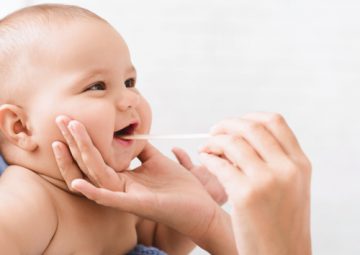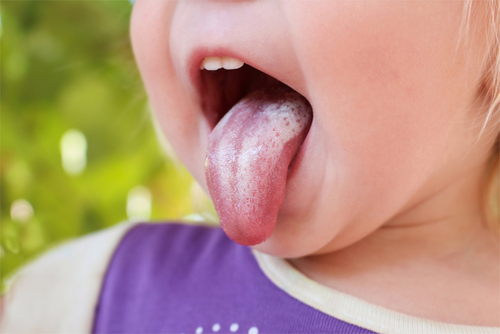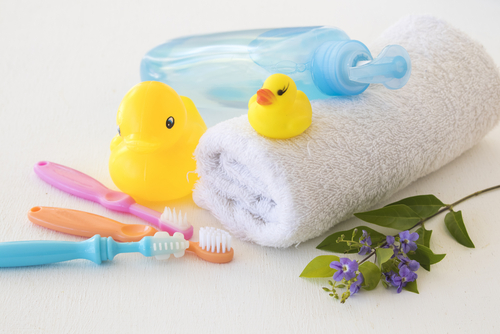
There is nothing more rewarding than making a baby smile. Who can resist the adorableness of an infant’s grin? As parents, we want to see and keep that wonderful smile on our babies’ faces as much as possible. And taking care of their oral hygiene is one of the best ways to accomplish that.
Contrary to popular belief, infant dental care doesn’t start just when a baby’s first tooth emerges. You need to care for your baby’s oral cavity way before then with toothbrushes, teethers, and tongue cleaners. Let’s find out how a tongue cleaner can benefit and improve your tiny one’s dental health.
What’s the Use of Baby Tongue Cleaners?
A tongue cleaner is a dental tool that helps remove toxic microorganisms on your child’s tongue. There are plastic, copper, and even stainless steel tongue cleaners, but it’s best to use a soft silicone scraper for an infant.
Many would argue that baby tongue cleaners are not necessary. However, we believe using one can actually make a huge improvement in your baby’s dental health for these reasons.
For Thorough Tongue Cleansing
Babies naturally have less saliva production, making them unable to wash away food residue. Milk and food residue can contain harmful microorganisms like bacteria and fungi. If the tongue is left uncleaned, these microbes will multiply and form a thin layer over the tongue, dulling the taste buds and hindering your child from fully enjoying their meals.
A tongue cleaner effectively removes any residue left in the mouth, keeping the tongue bacteria- and germ-free. Along with a finger toothbrush and a damp washcloth, tongue cleaners can keep your infant’s mouth clean and fresh.
Prevention of Dental and Health Problems
Bacteria buildup develops into a sticky substance called soft plaque. Once it multiplies, plaque hardens and grows into tartar. And tartars can greatly threaten your baby’s dental health, causing several dental infections.
Moreover, some dental issues can affect the child and their mother if left untreated. For example, infections such as oral thrush can be passed to the mother’s nipple during breastfeeding. However, proper oral hygiene practices—such as brushing and tongue scraping regularly—stop dental issues before they can even begin.
Introduction to Oral Hygiene Habits
The earliest baby tooth pops up at six months, and, naturally, that’s the time babies will start using toothbrushes. However, teaching your child dental hygiene habits way before then is crucial for their overall well-being.
Cleaning with a washcloth and a tongue cleaner will allow your child to familiarize themselves with these dental tools in their mouth. Doing so will help them form oral hygiene habits and prepare them for the transition to brushing.

What Happens if You Neglect a Baby’s Oral Hygiene?
You must thoroughly clean your child’s mouth and tongue to prevent bad oral hygiene. If you leave your baby’s mouth unattended, bacteria and other harmful microorganisms will rapidly multiply and thrive in their oral cavity, resulting in various dental problems like oral thrush, gum disease, and tooth decay.
Oral Thrush Infection
It’s common for babies to have white tongues because they mainly consume milk. The milk residue causes their tongues to whiten. But when you clean your child’s mouth and still see little white spots on their tongue and inner cheeks, it might be time to get your little one checked.
White spots in the mouth and lips indicate an oral thrush infection. Oral thrush is caused by the buildup of a fungus called Candida albicans in an infant’s oral cavity. This fungus is a naturally occurring organism found in our digestive tract.
However, since a baby’s immune system has yet to develop fully, fungal accumulation due to neglect can cause severe damage to a baby’s dental health. This fungal infection manifests as little white sores in and around a toddler’s mouth.
Cleaning your child’s tongue and mouth daily can prevent an oral thrush infection. For some babies, the sores naturally disappear after two weeks. However, parents are highly advised to consult with a pediatric dentist and have them prescribe an antifungal treatment for their child.
Early Gum Disease
Infant gums aren’t safe from infection. If bacteria accumulate in the oral cavity, your child will likely develop gingivitis or gum disease. This disease causes inflamed and swollen gums and may sometimes cause them to bleed. Bad breath is also a huge indication of this infection.
Gingivitis is caused when bacteria accumulate in soft plaque on teeth and around the gums and irritate these areas. Eventually, if left undisturbed, plaque accumulates into tartar, which can cause more gum inflammation. Excessive gum inflammation may lead to more severe diseases if left untreated.
Experts advise parents to have their infants treated at the first sign of gingivitis. In addition, it is recommended to have the plaque and tartar removed as soon as possible to lessen the chance of more infection.
Early Childhood Tooth Decay
Despite what many people may believe, tooth decay can infect teeth as soon as they first pop up at six months. Tooth decay manifests in the form of dark stains and little holes or cavities on a tooth’s surface. Prolonged exposure to acid-producing bacteria found in sugary, starchy food and saliva can cause tooth decay.
Similar to gingivitis, bacteria and plaque develop and cover the tooth surface. The toxins produced by bacteria attack the tooth, carving pits and cavities on a tooth’s exterior. These cavities can cause pain and tooth sensitivity, affecting and troubling a baby’s eating habits.
Parents are advised to have their infant regularly checked by a dentist to prevent the formation of cavities. In addition, it’s best to remove bacteria and plaque as soon as possible to avoid more serious dental problems.
Let’s Get To Tongue Cleaning!
Now that you are aware of the importance of tongue scraping and how dangerous dental neglect can be, it’s time to know how to care for and clean an infant’s tongue and mouth. Here are five simple steps to cleansing a baby’s tongue.
- Thoroughly wash your hands before cleaning your baby’s mouth. Always remember this step. The purpose of cleaning your infant’s mouth is to remove bacteria—that can’t happen if your hands are dirty and filled with bacteria themselves!
- Hold your infant’s head in a comfortable and safe position. Gently and softly cradle their head in your hand as you clean.
- Grab a washcloth or a tongue cleaner. You can use gauze, washcloth, or silicone tongue scraper to remove milk and food residue in your toddler’s mouth. Be sure to have warm water by your side to cleanse off the gunk.
- Slowly pry their mouths open. Do not forcefully open your baby’s mouth. Instead, simply place your finger near their mouth and wait for them to open up for you.
- Clean your toddler’s mouth. Gently massage their tongue, gums, and inner cheeks in circular motions using a washcloth. Lightly graze the length of the tongue with a tongue scraper. Do not add too much pressure. Repeat until the mouth and tongue are clean.

Tongue-tastic Tips
Knowing how to clean a baby’s oral cavity can already make a huge difference to your child’s well-being. So why stop there? Before we let you go, here are some reminders to keep in mind while you care for your baby’s dental hygiene.
- Make it a habit to clean your baby’s mouth after each meal. Clean their mouths twice a day.
- Visit a pediatrician for regular checkups. See a pediatric dentist once your infant’s first tooth appears.
- Avoid feeding your child too many sweets, like candies and gummies. Avoid sugary drinks as well, like fruit juices and soft drinks.
- Do not let your baby sleep while feeding on their milk. Babies must have clean gums, teeth, and tongues before sleep.
- For babies younger than 18 months, use warm water to clean their oral cavity.
- For toddlers aged 18 months to 3 years, use pea-sized amounts of fluoride toothpaste while brushing your baby’s teeth.
- Brush your child’s teeth for two minutes. Singing a nursery rhyme is a fun way to estimate your baby’s brushing time while keeping your tiny one entertained.
Keep Your Baby’s Breath Fresh with Ashtonbee
Dental healthcare must begin as early as your baby enters the world. Don’t wait for bacteria, germs, and fungi to build up in your toddler’s mouth to start proper oral hygiene practices! Grab your dental essentials at Ashtonbee today.
Ashtonbee’s 6-piece tongue cleaner set can eliminate all bacteria and thoroughly cleanse your infant’s tiny mouth. Our tongue cleaners have a curved cleaning edge to remove all the gunk and goo from their oral cavity. These non-toxic FDA-approved tongue scrapers are guaranteed to keep your baby clean and fresh.
We also offer other dental tools like baby toothbrushes and teether toys. Browse through our selection and find the essentials that suit your baby’s needs now!



